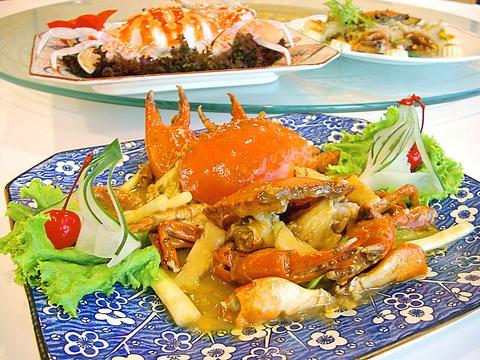For those who appreciate Chinese cuisine the arrival of autumn means hairy crabs. In order to survive cold winters, lake crabs preserve fat during the autumn season, which makes for rich crab roe, fresh taste and a tender texture.
Restaurants have their favored way of preparing the dish, but the 12 crab dishes presented at the Dynasty restaurant, Cesar Park Taipei, possibly have the most variety and reasonable prices.
Wok-fried soft shell crab (NT$160) is a simple and crispy dish. Chef Andy Ho (

PHOTO: YU SEN-LUN, TAIPEI TIMES
Braised whole crab in curry sauce (NT$1,380) offers a spicier taste. Solid king crabs weigh around 1kg each. First the crabs are deep fried and then sauteed with curry sauce, Guilin chili sauce and coconut. This kind of crab is special because of its plentiful and firm meat and it is well complemented by the mild curry sauce. Dip French baguettes into the sauce to finish off the dish.
Another strong taste is whole crab with butter sauce. The diced crabs are first fried to seal the meat, then sauteed with ginger, green onions and butter, before being simmered in thick chicken stock. Using your fingers and sucking the butter-flavored sauce may not look good, but it's the best way to enjoy the dish.
If you're looking for the ultimate taste in crab meat, try cold whole crab chiu-chow style (NT$580). The spotted crab, known for the colorful blue streaks on its shell, as well as its sweet and delicate meat, is famous. As such the best way of preparing this crab and keeping its taste is to just steam it lightly. Take a fat piece of crab leg and dip it in the red vinegar and sliced ginger for a deluxe meal.
The restaurant also offers choices of seasonal crab set menus priced from NT$800 to NT$1,388, which give you seven to nine crab dishes.

June 9 to June 15 A photo of two men riding trendy high-wheel Penny-Farthing bicycles past a Qing Dynasty gate aptly captures the essence of Taipei in 1897 — a newly colonized city on the cusp of great change. The Japanese began making significant modifications to the cityscape in 1899, tearing down Qing-era structures, widening boulevards and installing Western-style infrastructure and buildings. The photographer, Minosuke Imamura, only spent a year in Taiwan as a cartographer for the governor-general’s office, but he left behind a treasure trove of 130 images showing life at the onset of Japanese rule, spanning July 1897 to

One of the most important gripes that Taiwanese have about the Democratic Progressive Party (DPP) is that it has failed to deliver concretely on higher wages, housing prices and other bread-and-butter issues. The parallel complaint is that the DPP cares only about glamor issues, such as removing markers of Chinese Nationalist Party (KMT) colonialism by renaming them, or what the KMT codes as “de-Sinification.” Once again, as a critical election looms, the DPP is presenting evidence for that charge. The KMT was quick to jump on the recent proposal of the Ministry of the Interior (MOI) to rename roads that symbolize

On the evening of June 1, Control Yuan Secretary-General Lee Chun-yi (李俊俋) apologized and resigned in disgrace. His crime was instructing his driver to use a Control Yuan vehicle to transport his dog to a pet grooming salon. The Control Yuan is the government branch that investigates, audits and impeaches government officials for, among other things, misuse of government funds, so his misuse of a government vehicle was highly inappropriate. If this story were told to anyone living in the golden era of swaggering gangsters, flashy nouveau riche businessmen, and corrupt “black gold” politics of the 1980s and 1990s, they would have laughed.

It was just before 6am on a sunny November morning and I could hardly contain my excitement as I arrived at the wharf where I would catch the boat to one of Penghu’s most difficult-to-access islands, a trip that had been on my list for nearly a decade. Little did I know, my dream would soon be crushed. Unsure about which boat was heading to Huayu (花嶼), I found someone who appeared to be a local and asked if this was the right place to wait. “Oh, the boat to Huayu’s been canceled today,” she told me. I couldn’t believe my ears. Surely,